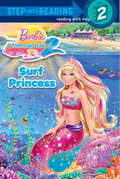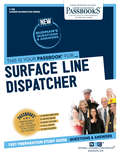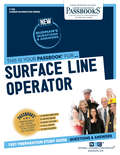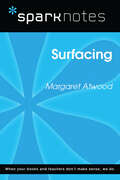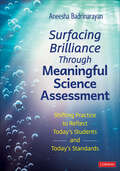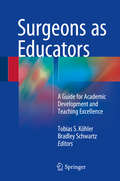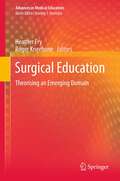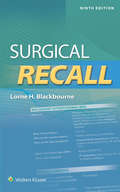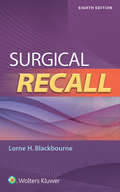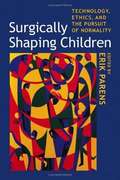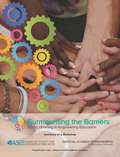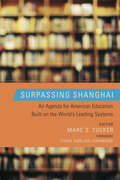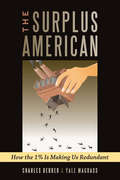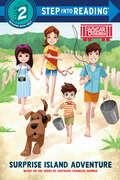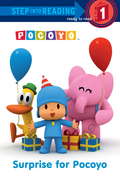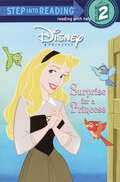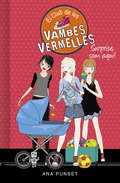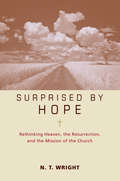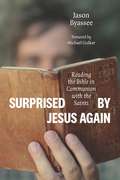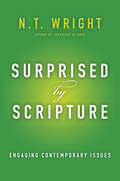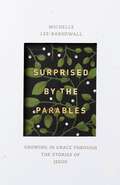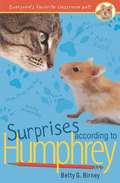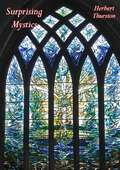- Table View
- List View
Surface Line Dispatcher: Passbooks Study Guide (Career Examination Series #C-788)
by National Learning CorporationThe Surface Line Dispatcher Passbook® prepares you for your test by allowing you to take practice exams in the subjects you need to study. It provides hundreds of questions and answers in the areas that will likely be covered on your upcoming exam.
Surface Line Operator: Passbooks Study Guide (Career Examination Series)
by National Learning CorporationThe Surface Line Operator Passbook® prepares you for your test by allowing you to take practice exams in the subjects you need to study. It provides hundreds of questions and answers in the areas that will likely be covered on your upcoming exam.
Surfacing (SparkNotes Literature Guide Series)
by SparkNotesSurfacing (SparkNotes Literature Guide) by Margaret Atwood Making the reading experience fun! Created by Harvard students for students everywhere, SparkNotes is a new breed of study guide: smarter, better, faster. Geared to what today's students need to know, SparkNotes provides: *Chapter-by-chapter analysis *Explanations of key themes, motifs, and symbols *A review quiz and essay topicsLively and accessible, these guides are perfect for late-night studying and writing papers
Surfacing Brilliance Through Meaningful Science Assessment: Shifting Practice to Reflect Today′s Students and Today′s Standards
by Aneesha BadrinarayanScience education is evolving–and our assessments should, too. The Next Generation Science Standards and similar standards based on A Framework for K-12 Science Education ushered in a bold vision focused on figuring out phenomena and problems, sensemaking that mirrors how scientists work, and real-world relevance. Although instruction has started to shift, assessment has too often lagged behind—failing to capture or support the depth, complexity, and creativity of meaningful science learning. Surfacing Brilliance Through Meaningful Science Assessment: Shifting Practice to Reflect Today’s Students and Today’s Standards is the essential guide for educators and leaders ready to rethink how we understand, evaluate, and support K-12 science learning. Written by Aneesha Badrinarayan, a leading voice in science education and assessment, this book offers a clear roadmap for designing assessments that surface the brilliance of young people in ways that are meaningful, equitable, and grounded in the lived realities of today’s classrooms. Drawing on four core priorities—sensemaking, relevance, assets, and opportunity—this book empowers educators to move beyond traditional tests to create assessments that reveal what students truly understand and can do. Bridging cutting-edge research and practical implementation, this book offers: Concrete strategies for using phenomena, problematizing strategies, and purposeful prompts to drive authentic sensemaking Frameworks and tools to develop relevant, asset-based assessments that reflect students’ strengths and experiences and are specific to a given classroom context Approaches to using data for targeted feedback and deeper learning A forward-looking chapter on how to meaningfully integrate AI into science assessment in an age of rapidly evolving technology Whether you’re a K–12 teacher, instructional leader, or assessment designer, Surfacing Brilliance Through Meaningful Science Assessment will transform how you think about using assessment to understand, evaluate, and support student learning. This guide ensures that educators and leaders assess students in ways that center student brilliance, embrace innovation, and inspire learners to achieve ambitious learning goals in science.
Surfacing Brilliance Through Meaningful Science Assessment: Shifting Practice to Reflect Today′s Students and Today′s Standards
by Aneesha BadrinarayanScience education is evolving–and our assessments should, too. The Next Generation Science Standards and similar standards based on A Framework for K-12 Science Education ushered in a bold vision focused on figuring out phenomena and problems, sensemaking that mirrors how scientists work, and real-world relevance. Although instruction has started to shift, assessment has too often lagged behind—failing to capture or support the depth, complexity, and creativity of meaningful science learning. Surfacing Brilliance Through Meaningful Science Assessment: Shifting Practice to Reflect Today’s Students and Today’s Standards is the essential guide for educators and leaders ready to rethink how we understand, evaluate, and support K-12 science learning. Written by Aneesha Badrinarayan, a leading voice in science education and assessment, this book offers a clear roadmap for designing assessments that surface the brilliance of young people in ways that are meaningful, equitable, and grounded in the lived realities of today’s classrooms. Drawing on four core priorities—sensemaking, relevance, assets, and opportunity—this book empowers educators to move beyond traditional tests to create assessments that reveal what students truly understand and can do. Bridging cutting-edge research and practical implementation, this book offers: Concrete strategies for using phenomena, problematizing strategies, and purposeful prompts to drive authentic sensemaking Frameworks and tools to develop relevant, asset-based assessments that reflect students’ strengths and experiences and are specific to a given classroom context Approaches to using data for targeted feedback and deeper learning A forward-looking chapter on how to meaningfully integrate AI into science assessment in an age of rapidly evolving technology Whether you’re a K–12 teacher, instructional leader, or assessment designer, Surfacing Brilliance Through Meaningful Science Assessment will transform how you think about using assessment to understand, evaluate, and support student learning. This guide ensures that educators and leaders assess students in ways that center student brilliance, embrace innovation, and inspire learners to achieve ambitious learning goals in science.
Surgeons as Educators
by Tobias S. Köhler Bradley SchwartzThis book is designed to provide the reader with comprehension of the principles of contemporary surgical education and skills to design and implement effective curricula that include learning theory, needs assessments, curriculum development, effective teaching methods, valid and reliable assessment of learners, and comprehensive program evaluation. This text will provide a comprehensive, state-of-the art review of this field and will serve as a valuable resource for anyone wishing to become a better educator regardless of the level of the trainee. The book will review how people learn and how to vary teaching methods accordingly. It will cover curriculum planning, measurement and performance assessment, teaching residents to teach, coaching, promoting professionalism, teaching surgeons to lead, and burnout. It will aid in identifying differences in generations and how to select students and residents who will thrive in your program. Specifics on teaching in the operating room, use of new technologies and honing of feedback skills will be addressed. The effect of duty hours and due process for struggling learners will also be addressed as well as preparing residents for beyond residency. Specifics on how to set up simulation centers and utilize this technology will also be discussed. These are a few of the topics which will prepare the reader to excel in education and thus be able to positively influence patient care well beyond that of any one individual.
Surgical Education
by Heather Fry Roger KneeboneSurgical Education: Theorising an Emerging Domain delineates surgical (as opposed to medical) education as a new and emerging field of academic enquiry. This reflects profound changes in healthcare training and practice on an international basis. As such, this book introduces, examines and explores the contribution of selected concepts and theories to surgical learning and practice. The first four chapters consider core facets of surgical education, such as simulation, while subsequent chapters take a key idea, often well known in another field, and examine its relevance to surgical education. Of course, performing invasive procedures is no longer the exclusive preserve of 'traditional' surgeons. Boundaries between surgery and the interventional specialties (radiology, cardiology, intensive care) are becoming increasingly blurred, especially as technology continues to expand. Changing work patterns and explosive technological development mark this out as a major growth area. New educational approaches (e.g. the use of simulation) are emerging. And all clinical practice is a team activity, where clinicians from many specialties (medicine, nursing, allied professions) come together with shared goals. For all the above groups, and their patients, education (teaching, training, learning and assessment) is of crucial importance. Yet the unique characteristics of surgical education have not previously been addressed from an educational perspective, nor have its possibilities as a new research domain been mapped. The domain needs to be theorised and its epistemological foundations established. There is thus both a need and a market for a definitive work in this area, aimed at surgeons, other clinicians, non-clinicians, educators, and others interested in this new domain.
Surgical Recal (Recall Series)
by Lorne BlackbourneBuild the Confidence for Success on Your Exams and in the Operating Suite! Written in a rapid-fire question-and-answer format ideal for learning on the go, this best-selling clerkship resource covers both general surgery and surgical subspecialties and provides accurate, on-the-spot answers to the questions most likely encountered during rotations and on the shelf exam. This enhanced ninth edition reflects the latest advances in key areas, as well as additional Rapid-Fire Review questions and new Rapid-Fire Vignettes to prepare students for success on exams and beyond.
Surgical Recall (Recall Ser.)
by Lorne BlackbourneWritten in a rapid-fire question-and-answer format, Surgical Recall is a best-selling, high-yield reference for clerkship students.
Surgically Shaping Children: Technology, Ethics, and the Pursuit of Normality
by Erik ParensAt a time when medical technologies make it ever easier to enhance our minds and bodies, a debate has arisen about whether such efforts promote a process of "normalization," which makes it ever harder to tolerate the natural anatomical differences among us. The debate becomes especially complicated when it addresses the surgical alteration, or "shaping," of children. This volume explores the ethical and social issues raised by the recent proliferation of surgeries designed to make children born with physical differences look more normal. Using three cases—surgeries to eliminate craniofacial abnormalities such as cleft lip and palate, surgeries to correct ambiguous genitalia, and surgeries to lengthen the limbs of children born with dwarfism—the contributors consider the tensions parents experience when making such life-altering decisions on behalf of or with their children. The essays in this volume offer in-depth examinations of the significance and limits of surgical alteration through personal narratives, theoretical reflections, and concrete suggestions about how to improve the decision-making process. Written from the perspectives of affected children and their parents, health care providers, and leading scholars in philosophy, sociology, history, law, and medicine, this collection provides an integrated and comprehensive foundation from which to consider a complex and controversial issue. It takes the reader on a journey from reflections on the particulars of current medical practices to reflections on one of the deepest and most complex of human desires: the desire for normality.
Surmounting the Barriers: Summary of a Workshop
by National Academy of Engineering"Surmounting the Barriers: Ethnic Diversity in Engineering Education" is the summary of a workshop held in September 2013 to take a fresh look at the impediments to greater diversification in engineering education. The workshop brought together educators in engineering from two- and four-year colleges and staff members from the three sponsoring organizations: the National Science Foundation, the National Academy of Engineering and the American Society for Engineering Education. While the goal of diversifying engineering education has long been recognized, studied, and subjected to attempted interventions, progress has been fitful and slow. This report discusses reasons why past recommendations to improve diversity had not been adopted in full or in part. "Surmounting the Barriers" identifies a series of key impediments, including a lack of incentives for faculty and institutions; inadequate or only short-term financial support; an unsupportive institutional and faculty culture and environment; a lack of institutional and constituent engagement; and inadequate assessments, metrics, and data tracking. The report also shares success stories about instances where barriers to diversity have been identified and surmounted, and the resources that could enable real solutions to implement steps toward progress.
Surpassing Shanghai: An Agenda for American Education Built on the World's Leading Systems
by Marc S. TuckerThis book answers a simple question: How would one redesign the American education system if the aim was to take advantage of everything that has been learned by countries with the world&’s best education systems? With a growing number of countries outperforming the United States on the most respected comparisons of student achievement—and spending less on education per student—this question is critical.Surpassing Shanghai looks in depth at the education systems that are leading the world in student performance to find out what strategies are working and how they might apply to the United States. Developed from the work of the National Center on Education and the Economy, which has been researching the education systems of countries with the highest student performance for more than twenty years, this book provides a series of answers to the question of how the United States can compete with the world&’s best.
Surplus American: How the 1% is Making Us Redundant
by Charles Derber Yale R. MagrassThe Surplus American considers a future where increasing numbers of Americans will be rendered jobless and redundant. Exploring the ongoing crisis of 'surplus people' today, authors Charles Derber and Yale Magrass show that the jobless are merely the tip of the iceberg. Drawing on the work of economists and highlighting new trends, the book identifies a number of primary groups within the category of 'surplus' including the underemployed, people forcibly removed or induced to leave the labour force and retirees. Derber and Magrass argue that a majority of the US public is now part of the surplus population constituting an integral part of the economy. The authors conclude that these movements will be essential to solving the crisis of surplus people and redirecting the economy in a more positive direction.
Surprise Island Adventure: Boxcar Children Early Reader (Step into Reading) (Step into Reading)
by Gertrude Chandler WarnerThe Alden children were searching for a home – and found a life of adventure! Beloved by generations of families, the second book in the Boxcar Children series—adapted into this Step 2 leveled reader—is full of wholesome fun, perfect for children who are learning to read simple sentences. The Aldens spend the summer on Grandfather's island! Joe, the island's friendly handyman, helps them with anything they need, but as the children continue to explore their summer home, they realize there is more to the island―and to their new friend―than meets the eye. Adapted from Gertrude Chandler Warner's Surprise Island chapter book, this early reader allows children to step into reading with a Boxcar Children classic.Step 2 Readers use basic vocabulary and short sentences to tell simple stories. For children who recognize familiar words and can sound out new words with help.
Surprise for Pocoyo (Pocoyo)
by Random House Christy WebsterPocoyo's friends are throwing him a surprise party. But will they be able to keep it a secret from curious little Pocoyo? Boys and girls ages 2-5 will love this Step 1 reader based on an episode of the popular Pocoyo TV series.
Surprise for a Princess (Step into Reading)
by Jennifer Liberts Weinberg RH DisneyIt’s Princess Aurora’s birthday, and the good fairies want to prepare a surprise for her without using any magic. Young readers will enjoy the fun and mayhem that ensues in this Step 2 reader based upon the Disney classic, Sleeping Beauty.
Surprise, som aquí! (Sèrie El Club de les Vambes Vermelles #Volumen 17)
by Ana PunsetViu una nova aventura amb les noies del Club de les Vambes Vermelles! Les noies del Club de les Vambes Vermelles estan en plena època d'exàmens i, a més, la Laia està fent de cangur de tres nens petits... Per què el dia no pot tenir més hores? Per sort, les seves amigues estan sempre a punt per ajudar-la. No hi ha dubte: juntes podem amb tot!
Surprised by Hope Participant's Guide: Rethinking Heaven, the Resurrection, and the Mission of the Church
by N. T. Wright Kevin HarneyGain an exciting new vision for your life on earth in light of your future in heaven. Wonderful as is the promise of heaven, a glorious hereafter is just part of what salvation is about. What about today? Jesus called his followers the salt of the earth and the light of the world. Your life here and now is of tremendous consequence, and what you believe about the future has a direct impact on how you live in the present. In six transforming, faith-inspiring sessions, premier biblical scholar N. T. Wright opens your eyes to the amazing full scope of what God's Word has to say about the world to come and the world that is. Designed for use with the video.
Surprised by Jesus Again: Reading the Bible in Communion with the Saints
by Jason ByasseeA bold, historical, robust approach to reading Scripture and encountering Jesus anewNo one expects to be surprised. Yet biblical interpretation can do exactly that. Christians expect to see Jesus as they read the Bible, but when and how Jesus actually speaks through Scripture can still surprise us!Drawing on the early church’s theological giants—Origen, Augustine, Gregory the Great, and more from the historical cloud of witnesses—author Jason Byassee models how we can recover ancient Christians’ multiple ways of reading the Bible to our benefit. As Byassee says, God himself is Jewish, Catholic, and Pentecostal—so much larger than our own little corner on the truth—and this book offers readers a refreshingly enhanced vision of the Bible and of Jesus himself.
Surprised by Jesus Again: Reading the Bible in Communion with the Saints
by Jason ByasseeA bold, historical, robust approach to reading Scripture and encountering Jesus anewNo one expects to be surprised. Yet biblical interpretation can do exactly that. Christians expect to see Jesus as they read the Bible, but when and how Jesus actually speaks through Scripture can still surprise us!Drawing on the early church&’s theological giants—Origen, Augustine, Gregory the Great, and more from the historical cloud of witnesses—author Jason Byassee models how we can recover ancient Christians&’ multiple ways of reading the Bible to our benefit. As Byassee says, God himself is Jewish, Catholic, and Pentecostal—so much larger than our own little corner on the truth—and this book offers readers a refreshingly enhanced vision of the Bible and of Jesus himself.
Surprised by Scripture: Engaging Contemporary Issues
by N. T. WrightBishop, Bible scholar, and bestselling author N. T. Wright here provides a series of case studies on how to apply the Bible to the pressing issues of today. Among the topics Wright addresses are the intersection of religion and science, why women should be allowed to be ordained, what we get wrong and how we can do better when Christians engage in politics, why the Christian belief in heaven means we should be at the forefront of the environmental movement, and many more.Wright fearlessly wades through the difficult issues facing us. Readers will find new models for understanding how to affirm the Bible in today's world as well as encouragement and renewed energy for deepening our faith and engaging with the culture around us. ts everyone Why the Christian belief in heaven means we should be at the forefront of the environmental movement And much moreHelpful, practical, and wise, Surprised by Scripture invites readers to examine their own hearts and minds and presents new models for understanding how to affirm the Bible in today's world--as well as new ideas and renewed energy for deepening our faith and engaging with the world around us.
Surprised by the Parables: Growing in Grace through the Stories of Jesus
by Michelle Lee BarnewallJesus' parables can't simply be interpreted, they must be experienced. In the gospels, Jesus used parables to teach transformative lessons and convey deep spiritual truths about the kingdom of God. But he often used them to confront and challenge his audience as well, forcing them to open or close their hearts to the kingdom. Jesus understood the power of stories, but there are some things lost in translation when we try to interpret those same stories thousands of years removed from their original context. The unexpected twists and surprises in the parables might be missed by a modern audience because they're unfamiliar with the underlying points of reference. In Surprised by the Parables, Michelle Lee Barnewall explores the ancient context these parables drew from. These stories of grace reveal many of the mysteries central to God's character, and understanding the ancient world behind them will help us see the parables from a new perspective.
Surprises According to Humphrey (According to Humphrey #4)
by Betty G. BirneyA classroom hamster has to be ready for anything, but suddenly there are LOTS-LOTS-LOTS of big surprises in Humphrey's world. <P><P> Some are exciting, like a new hamster ball. <P><P>But some are scary, like a run-in with a cat and a new janitor who might be from another planet. <P>But even with all that's going on, Humphrey finds time to help his classmates with their problems. <P>But will Mrs. Brisbane's unsqueakable surprise be too much for Humphrey to handle?
Surprising Mystics
by Herbert ThurstonThe renowned Jesuit author Herbert Thurston's final book about one of his favorite topic—mystics and their extraordinary experiences in which he reviews the lives of Margery Kempe of Lynn, Anne Catherine Emmerich, Domenica dal Paradiso, et al."Remarkable collection of studies of eccentric sanctity...of extreme interest." Times Literary Supplement"So much was [Fr. Thurston] a priest as well as a scholar, so lovingly intent on the study of the mystic as a whole person, that these 13 biographical sketches remind one of a series of brilliant tapestries, peopled by figures almost alive."-BlackfriarsHerbert Henry Charles Thurston SJ (15 November 1856 – 3 November 1939) was an English priest of the Roman Catholic Church, a member of the Jesuit order, and a prolific scholar on liturgical, literary, historical, and spiritual matters. In his day, he was regarded as an expert on spiritualism. Today he is remembered chiefly for his extensive contributions to the Catholic Encyclopedia.
